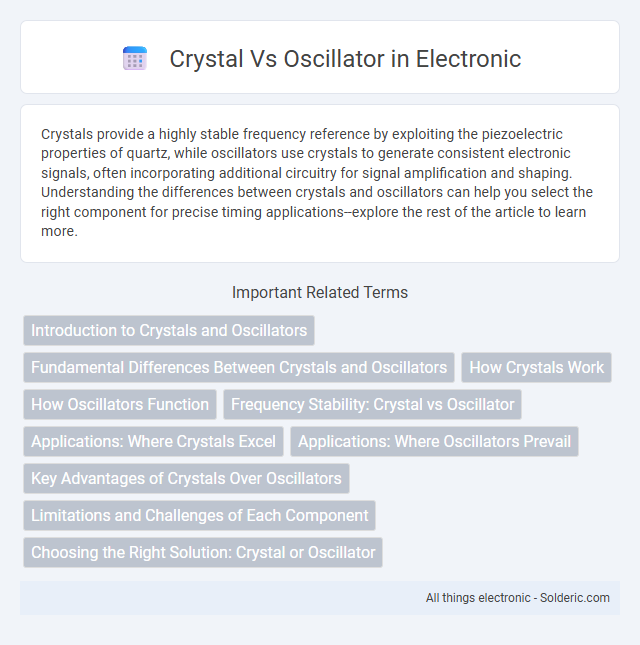Crystals provide a highly stable frequency reference by exploiting the piezoelectric properties of quartz, while oscillators use crystals to generate consistent electronic signals, often incorporating additional circuitry for signal amplification and shaping. Understanding the differences between crystals and oscillators can help you select the right component for precise timing applications--explore the rest of the article to learn more.
Comparison Table
| Feature | Crystal | Oscillator |
|---|---|---|
| Definition | Piezoelectric quartz device providing stable frequency | Electronic circuit generating a repetitive signal |
| Function | Frequency reference component | Signal source including crystal or RC types |
| Frequency Stability | High stability (+-10 ppm or better) | Varies; crystal oscillator offers high stability |
| Output Signal | None (passive component) | Sine, square, or other waveforms (active output) |
| Power Requirement | None (passive device) | Requires external power |
| Applications | Frequency control in radios, clocks, microcontrollers | Clock generation, timing in computers, communication devices |
| Complexity | Simple component | Complex circuit |
| Cost | Lower | Higher (due to additional electronics) |
Introduction to Crystals and Oscillators
Crystals and oscillators are essential components in electronic circuits, providing precise frequency control. Crystals, made from quartz, utilize piezoelectric properties to generate stable oscillations, while oscillators are electronic circuits that convert these mechanical vibrations into consistent electrical signals. Your choice between them influences timing accuracy and circuit performance in applications like clocks, radios, and microprocessors.
Fundamental Differences Between Crystals and Oscillators
Crystals are passive components that utilize the piezoelectric effect to produce a stable resonant frequency, whereas oscillators are active circuits combining a crystal with amplifying elements to generate a consistent output frequency. Crystals alone cannot produce an oscillating signal without external circuitry, while oscillators provide a self-sustaining waveform critical for timekeeping and frequency control applications. The fundamental difference lies in the crystal serving as a frequency reference and the oscillator delivering a usable signal based on that reference.
How Crystals Work
Crystals work by exploiting the piezoelectric effect, where applying an electric field causes the quartz crystal to vibrate at a precise frequency. This stable vibration generates a consistent oscillation, essential for timing devices like watches, microcontrollers, and communication systems. You rely on crystals for accurate frequency control because their mechanical resonance ensures minimal frequency drift under varying environmental conditions.
How Oscillators Function
Oscillators generate precise electrical signals by using a quartz crystal's piezoelectric properties to maintain a stable resonance frequency, which ensures consistent timing in electronic circuits. The crystal acts as a frequency-determining component, vibrating mechanically when electric current passes through it, producing a reliable oscillation. Your device's performance depends on this oscillation for accurate signal generation, frequency control, and clock synchronization.
Frequency Stability: Crystal vs Oscillator
Crystals exhibit superior frequency stability compared to oscillators due to their precise mechanical resonance properties, maintaining consistent frequencies over temperature variations and aging. Oscillators relying on other components, such as RC or LC circuits, tend to show higher frequency drift influenced by environmental factors. The quartz crystal's inherent piezoelectric characteristics enable minimal frequency deviation, crucial for applications demanding high timing accuracy.
Applications: Where Crystals Excel
Crystals excel in applications requiring precise frequency control, such as in wristwatches, smartphones, and GPS devices due to their high stability and accuracy. They are ideal for timing circuits and frequency references in microprocessors and communication equipment. Unlike oscillators, crystals provide a fixed frequency that ensures reliable performance in sensitive electronic systems.
Applications: Where Oscillators Prevail
Oscillators dominate in applications requiring stable and accurate frequency generation such as microcontrollers, communication systems, and signal processing devices. Unlike basic crystals that provide a fixed resonant frequency, oscillators integrate active components enabling continuous waveform generation for clocks, timers, and radio transmitters. Their versatility and precision make oscillators indispensable in digital electronics, RF circuits, and timing control systems.
Key Advantages of Crystals Over Oscillators
Crystals offer superior frequency stability and precision compared to oscillators, making them ideal for applications requiring accurate timing. They have lower phase noise and higher Q factors, which enhance signal integrity and reduce jitter in electronic circuits. Your designs benefit from the compact size and low power consumption of crystals, ensuring reliable performance in compact, battery-powered devices.
Limitations and Challenges of Each Component
Crystals offer high frequency stability but face limitations such as sensitivity to mechanical shock and temperature variations, which can cause frequency drift. Oscillators, while providing signal generation flexibility, can suffer from phase noise, aging effects, and power consumption issues, impacting long-term reliability. Understanding these challenges helps you select the appropriate component for precision and durability in your electronic design.
Choosing the Right Solution: Crystal or Oscillator
Selecting the right timing component depends on application requirements such as frequency accuracy, stability, and power consumption. Crystals offer precise frequency control and low phase noise, ideal for cost-sensitive or space-constrained designs. Oscillators include built-in circuitry, providing a ready-to-use signal output with simplified integration and better temperature compensation, suitable for complex or high-performance systems.
crystal vs oscillator Infographic

 solderic.com
solderic.com